|
Getting your Trinity Audio player ready...
|
Inside Out 2 will take fans of the first film to a destination that’s both wondrous and sometimes even a little scary — the mind of a kid grappling with teen-dom.
Riley, the main character of Inside Out, has grown a few years since the first film was released in 2015. She’s facing a new set of challenges, ranging from puberty to friendship dynamics. So, the filmmakers, inspired by their own tenuous walks through this phase of life, added four new emotions — Anxiety, Ennui, Envy and Embarrassment. (The original movie’s Joy, Sadness, Fear, Anger and Disgust are still part of Riley’s brain as well.)

Kelsey Mann (story supervisor for The Good Dinosaur and Onward) directs the film with a keen eye on how he himself changed as he moved toward his teen years. As he went through old photos of himself growing up, he noticed that as a kid he initially loved the attention of birthdays. Once he hit middle school age, photos of him showed that he was uncomfortable with attention and would give anything just to be left alone.
“[After looking at my photos], I really thought it was those emotions that show up at this age, and we suddenly become self-conscious,” says Mann. “In the early days on this movie, I got a lot of research that says this is exactly what happens to us in our brains when we’re 13. And we are hard-wired to do that. You start to look and compare yourself to others. And there’s a reason for it. That’s because we need to be able to survive out in society and be amongst other people and make sure that you’re safe and protected. It’s kind of this protection thing that kicks on at this age, but with it comes a whole other side of new emotions that can be really damaging if they take over and aren’t managed the right way, which is where the spirit of this movie came from.”
Mann and his team decided Anxiety would be a powerful driving force for the film right away, but they also knew some emotions wouldn’t quite fit or would become too heavy. Feelings like shame and guilt seemed too heavy to bring into the mix, especially when they would already have four new emotions to manage.
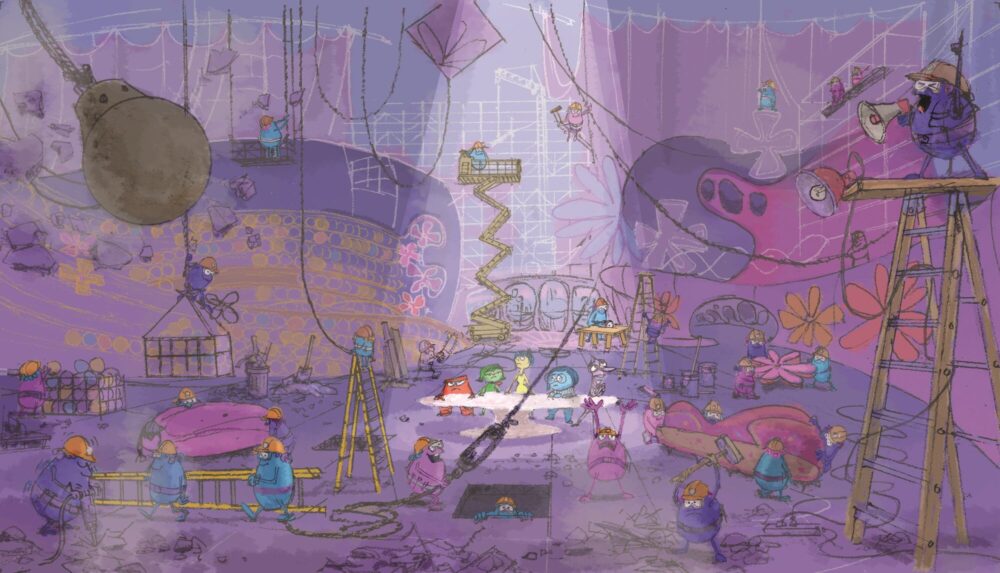
With Anxiety as a core influence on the film, it’s not surprising that director of layout photography Adam Habib mentions the Adam Sandler-starring drama Uncut Gems as a deep influence on the visual language of the film. The shaky cinematography of the Safdie Brothers movie inspired their technique. The Inside Out 2 animation team built static sets during production and then put the digital characters inside those sets. Then they put a virtual camera that could be used like a camera for a live-action film inside the sets. Once this was done, they would move the virtual camera around the sets they’d made to try out new angles and shot setups to see what would work best for the movie.

With so many fans of the original film, the filmmakers understood they’d have to be especially careful as they worked with the characters in updated software. Production designer Jason Deamer loved that the newer tools gave them the opportunity to make more visually complex characters with more detailed, evocative elements. Previously, some elements had to be created using more of a painterly shading technique, while now they were able to do things like make Sadness from woven CG threads.
“We’re still keeping with the original feeling of the character, and this is the same character,” says Deamer. “But it’s even better, more visually interesting.”
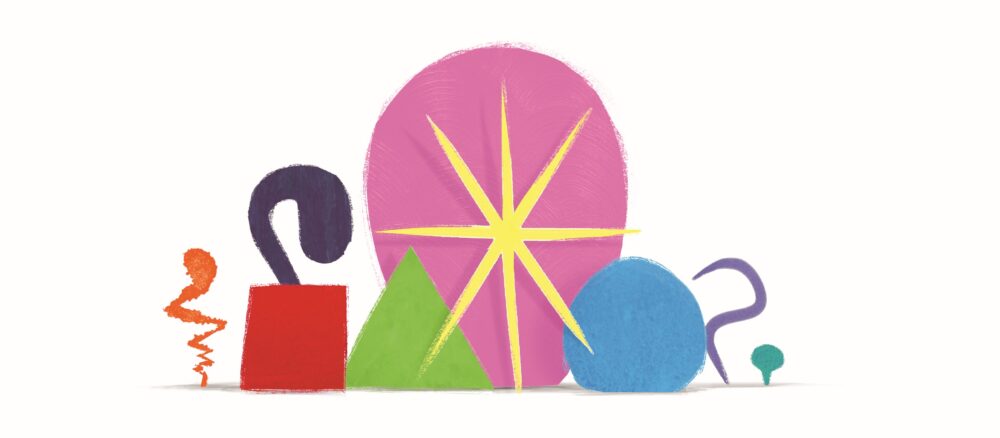
Mann looked at the simple color and shape language of the first film as a perfect jumping-off point for what he would do in the next installment of Riley’s story.
“The first film created just a great shape and color language for each character,” says Mann. “It was all boiled down to a basic color and a basic shape that felt right for each emotion. In this film, I wanted a nice variety of a small character and a large one. We played around with who those could be and then we got really excited about the idea that Envy would be the smallest, because she’s so envious that others can reach the console to control Riley and she can’t reach it. Envy is the feeling that you wish you had what others have, including the ability to reach this console. That gave us seeds of things that we could do visually. If Envy wishes that she was as tall as everyone else but can’t be and struggles with it, then that would be funny.”
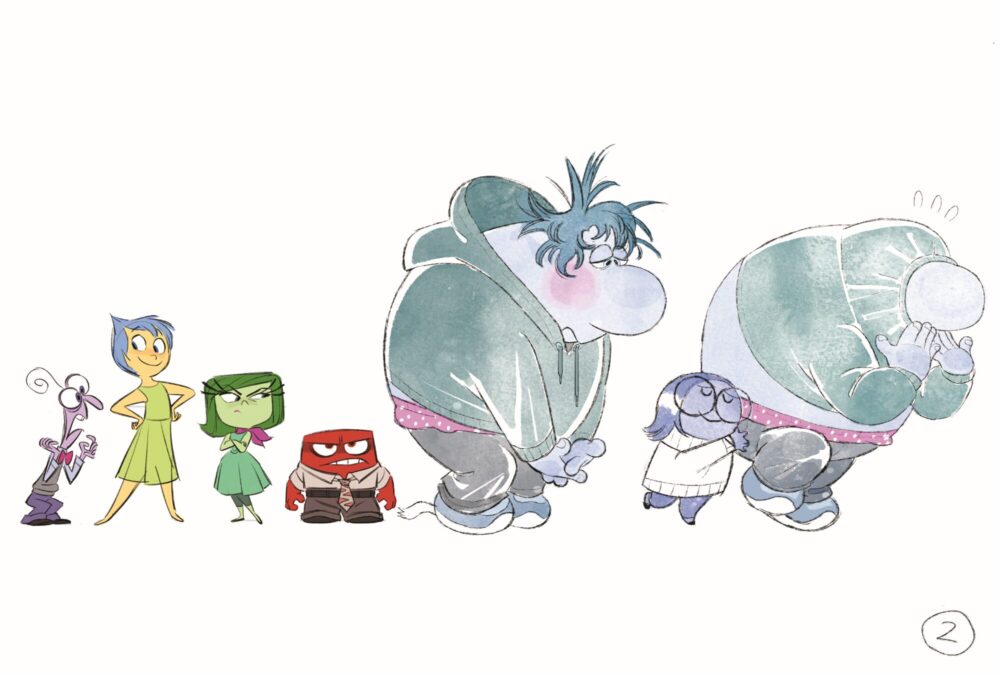
The flip side was true for Embarrassment, who was originally a smaller character around the size of Sadness. “But then I thought he should be the biggest because really when you’re embarrassed, you really want to hide,” recalls Mann. “If he’s the largest character, he can’t hide. We thought it would be so funny if even though he desperately tries to hide in his hoodie, he can’t because his nose peaks out when he tries to zip up into that hoodie. He literally cannot escape and hide when he really wants to do so. And this smooth, colorful world where you see the emotions is in direct contrast with Riley’s teen ‘real’ world where the colors are muted and muddy and not very bright, which reflects how she’s struggling at this time in her life. There are definitely two worlds, existing side by side in the film.”
Most of the voice cast returned and some notable newcomers were added for Inside Out 2. Amy Poehler voices Joy again, Phyllis Smith (The Office) is Sadness, Lewis Black is back as Anger, Diane Lane reprises her role as Riley’s mom, Ayo Edebiri (The Bear) plays Envy, Maya Hawke joins as Anxiety, Lisa Lapira is Disgust (originally voiced by Mindy Kaling), Tony Hale voices Fear (originally voiced by Bill Hader), Paul Walter Hauser is Embarrassment and French actor Adèle Exarchopoulos voices Ennui. Kensington Tallman plays Riley.
The Perfect Voice
“When I first heard Maya as Anxiety, I knew this was it,” says Mann. “She had a real connection to the character. I had to meet her during my vacation at Disney World because of scheduling, and it was amazing. I was taken to a room somewhere in the back of the park, and we got on a Zoom call. Maya completely crushed it. We discussed what I wanted for the character in the movie and how her character would relate to the other characters. She understood it right away and I think you can hear it in her performance. It was great to find someone who knew this character from the beginning.”
When Mann and the crew wanted to test the film for authenticity, they often discussed with their own teenage daughters who had gone through the awkwardness and friendship struggles shown in the film. When their kids told them they’d created a story that rang true, the filmmakers knew they had reached their goal.
“This is a time that’s hard for everyone,” says Mann. “If we can talk about it in an entertaining way that can open doors for families and friends to discuss what’s happening. And then maybe it won’t be as hard to go through it or you won’t feel as alone if you know this is what it’s like for everyone.”
Disney/Pixar’s Inside Out 2 will open in theaters nationwide on June 14.
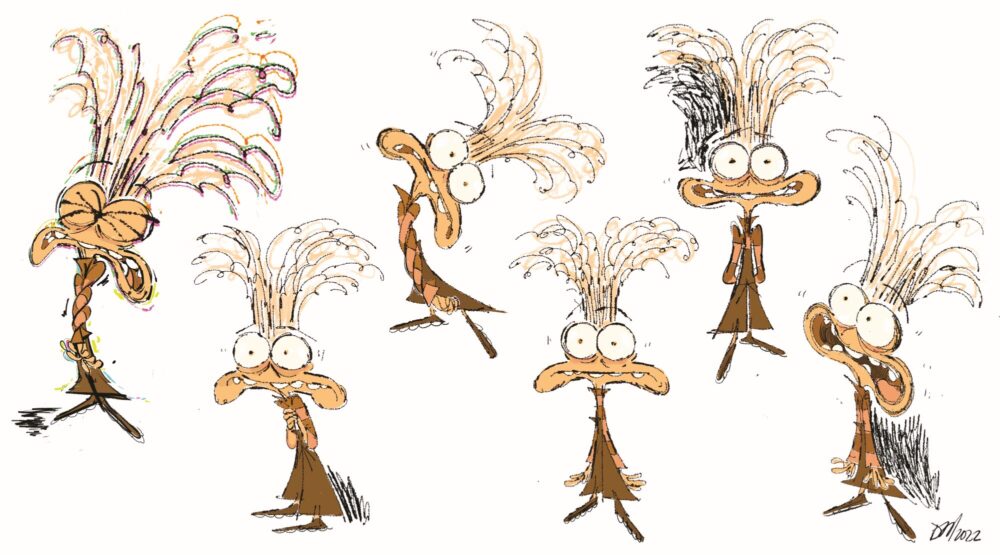
All About Anxiety
Inside Out 2’s most dominant character by far is Anxiety. With her frayed orange hair and almost bug-like eyes, she’s a study in the kind of tension that comes from worrying about what comes next. Director Kelsey Mann made her the focus of Riley’s teenage brain for a reason.
“This is when you’re afraid of doing something wrong, of your friends making fun of you, of looking like you don’t know what you’re doing,” says Mann. “And that’s anxiety. That’s what it does. You’re never in the moment. We thought orange was the color that made sense for anxiety. The type of orange we used has the feeling of anxiety, and you can see the kind of thoughts that are going through the character’s mind because of the expression on her face.”
Although Joy seemed like a more dominant character in the first film, Mann thought Anxiety should pop up in Riley’s brain in a way that shows how the focus of the teen’s thoughts have shifted. Many of the filmmakers had also dealt with anxiety in their lives and thought it could be especially powerful to watch Riley deal with it just as she’s getting ready to move on to high school.
“Anxiety is going to try to take control of the console every time, and Maya Hawke knew how to get that sound in her voice when she took on this character,” says Mann. “And the other emotions like Joy might try to take control from her, but it’s almost impossible. There were lots of opportunities for us to have fun with that. Anxiety is always two steps ahead; she’s always thinking of the next move. Joy plays checkers but Anxiety plays chess. She can outmaneuver all of them.”
Forgotten Emotions and Places
When director Kelsey Mann and his team first began working on Inside Out 2 movie, they immersing themselves in the world of the original 2014 movie. “I started by rewatching every single screening of the first movie,” says Mann. “I just wanted to see if there was any gems that were in the original that that I could bring back in. One of them was the emotion of schadenfreude, the German expression for feeling joy at someone else’s expense! They had that idea for the first film, so we tried it again.”
Mann adds, “But for the first screening that we did, we had nine new emotions. I really wanted Joy to feel overwhelmed by all of these new emotions that showed up … but then, you couldn’t keep track. There were so many emotions and they all canceled each other out because you couldn’t keep up with everybody. And my first note from the first screening was ‘simplify.’ So we ended up with the emotions that really impacted Riley as she deals with being a teenager. I remember meeting with Dacher Keltner, a professor at Berkeley who was our emotional expert on the first film. He looked at our list of emotions and picked the ones that are the ‘self-conscious emotions’ … At that age, we’re hard-wired to become really self-conscious. We also push our parents and caregivers away is so that we can become independent people who can take care of ourselves.”
Among the other ideas that was left behind was Procrastination Land! “I loved that idea,” recalls Mann. “We had this new location called Procrastination Land, and the joke was that it was always under construction. The workers were always like., ‘Hey, should we start building this land today? And they’re like, ‘Nah, and they’re always on their phones. We even boarded it. But I just couldn’t fit in a natural way. It always felt forced. In these movies, you just need to make sure you’re having forward momentum and Procrastination Land is the opposite of that: It makes you sit down. So suddenly the movie would come to a complete halt!”




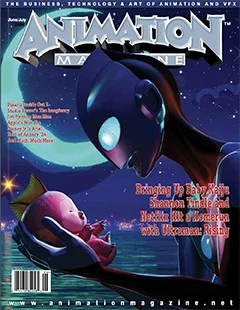
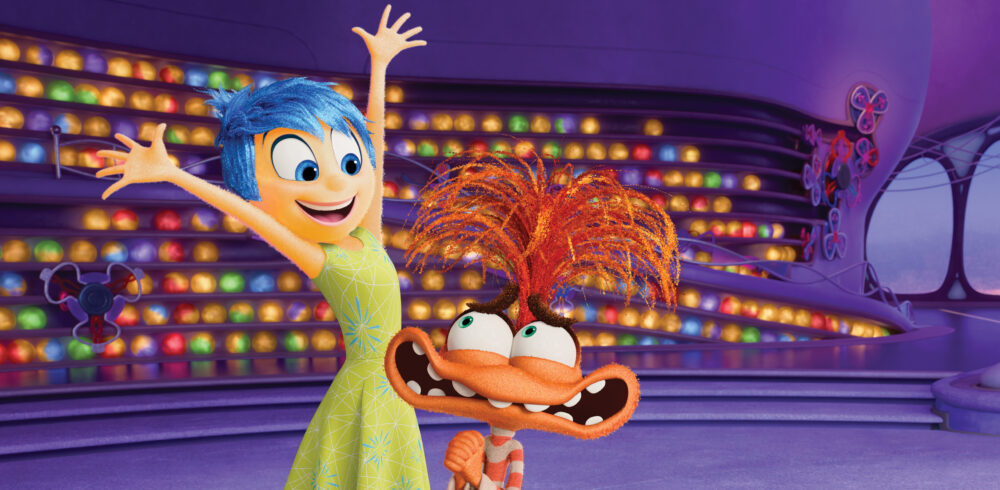

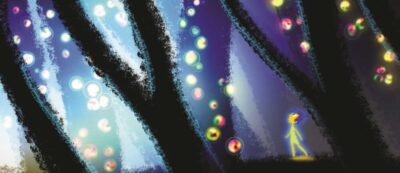

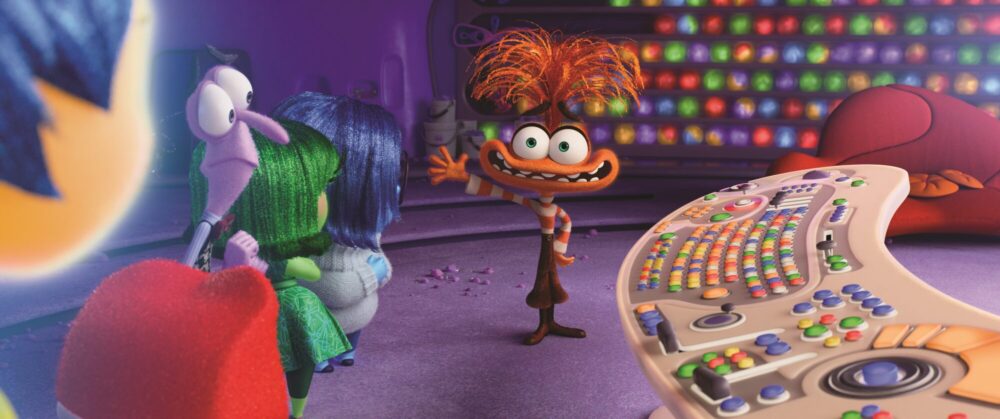


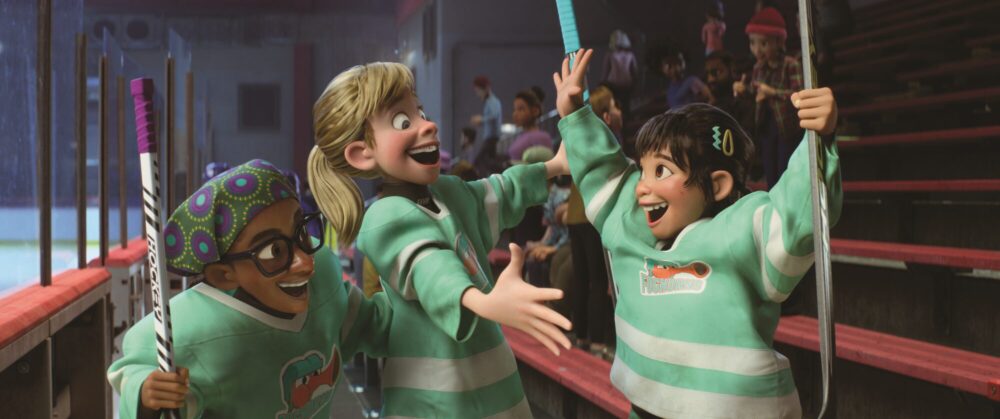


 Win a Funko X Lilo & Stitch Prize Pack!
Win a Funko X Lilo & Stitch Prize Pack! 
